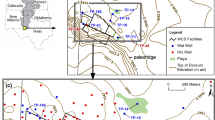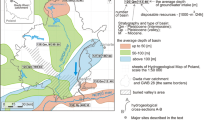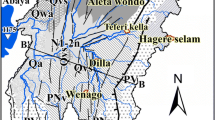Abstract
Perth groundwater resources are obtained from three major aquifers that occur beneath the Perth metropolitan area: the Superficial aquifer, Leederville aquifer and Yarragadee aquifer. Each aquifer has a unique seasonal water level pattern controlled by soils, geomorphology and geology. Landuse is mainly responsible for variations in recharge; however, the hydraulic properties control aquifer response and water level pattern to a greater degree. Groundwater in the three aquifers is generally of very good quality except in localised areas. Salinity increases with depth and in direction of groundwater flow in the three aquifers. The best water quality is in the Superficial aquifer in the Wanneroo well field area. The geochemistry and stable isotope signatures from the three major aquifers revealed distinct water types that suggest very little hydraulic connection or mixing of waters between these aquifers at the present abstraction and recharge regimes. The results also show that the Leederville and Yarragadee aquifers were recharged during earlier cooler times while the Superficial aquifer is being recharged at present.
Similar content being viewed by others
References
Cargeeg, G. C., Boughton, G. N., Townley, L. R., Smith, G. R., Appleyard, S. J. and Smith, R. A.: 1987, Perth Urban Water Balance Study, Volume 1, Findings, Water Authority of Western Australia, Perth.
Davidson, W. A.: 1995, ‘Hydrogeology and groundwater resources of the Perth region, Western Australia’, Geological Survey of Western Australia, Bulletin 142.
McArthur, W. M. and Bettenay, E.: 1960, ‘The development and distribution of the soils of the Swan Coastal Plain, Western Australia’, Soil Publication No 16, CSIRO, Melbourne.
Piper, A. M.: 1944, ‘A graphical procedure in the geochemical interpretation of water analyses’, Am. Geophys. Union Trans. 25, 914–923.
Salama, R. B., Silberstein, R. and Pollock, D.: 2005, ‘Soils characteristics of the Bassendean and Spearwood Sands of the Gnangara Mound (Western Australia) and their controls on recharge, water level patterns and solutes of the Superficial Aquifer’, this issue.
Thorpe, P. M. and Davidson, W. A.: 1991, ‘Groundwater age and hydrodynamics of the confined aquifers, Perth, Western Australia’, in Proceedings of the International Conference on Groundwater in Large Sedimentary Basins, Perth, Western Australia, 1990, Australian Water Resources Council, Conference Series No 20, pp. 420–436.
Townley, L. R., Turner, J. V., Barr, A. D., Trefry, M. G., Wright, K. D., Gailitis, V., Harris, C. J. and Johnston, C. D.: 1993, Wetlands of the Swan Coastal Plain, Volume 3, Interaction Between Lakes, Wetlands and Unconfined Aquifers.
Townley, L. R. and Turner, J. V.: 1990, ‘Flow of groundwater through shallow lakes and wetlands’, Land Water Res. News 7, 28–31.
Turner, J. V. and Thorpe, P. M.: 2003, ‘Palaeotemperature conditions for the southwest of Western Australia from the stable isotopic composition of deep, confined groundwater within the Perth Basin’, IAEA Extended Abstract 2002.
Author information
Authors and Affiliations
Corresponding author
Rights and permissions
About this article
Cite this article
Salama, R.B. Interconnectivity between the Superficial Aquifer and the Deep Confined Aquifers of the Gnangara Mound, Western Australia. Water Air Soil Pollut: Focus 5, 27–44 (2005). https://doi.org/10.1007/s11267-005-7395-9
Issue Date:
DOI: https://doi.org/10.1007/s11267-005-7395-9




